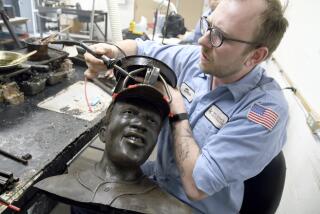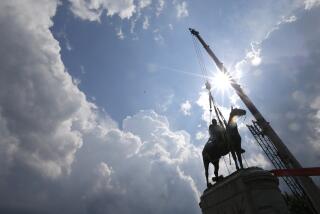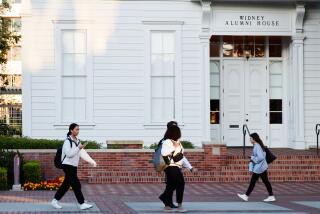Appomattox for This General : Mascots: High school bans life-sized statue of Lee, but former students bring it out on special occasions.
- Share via
The true depth of mascot love was put to a rigorous test at Houston’s Robert E. Lee High, home of the Generals.
Beginning in the mid 1980s, officials launched a program to eradicate what they saw as offensive relics of the school’s heritage. Phased out were the playing of “Dixie” as the fight song and the waving of Confederate Stars and Bars flags at sporting events. The school’s colors, gold and gray, were changed to gold and black.
These alone were cherished traditions and were missed by students and alumni. However, the final blow came when Lee High’s beloved mascot--a life-sized fiberglass statue of Civil War General Robert E. Lee--was banned from campus.
It had been tradition for Uncle Bob, as the 250-pound statue was known, to be stored on campus under the care of a group of students known as Uncle Bob’s Boys. The Boys’ job was wheel Uncle Bob to football games. Once at the games, Uncle Bob’s chief role, aside from providing inspiration to the team and fans, was to point toward the opponent’s end zone.
Uncle Bob was constructed with his left arm pointing straight out. It was the Boys’ duty to wheel Bob around to ensure the arm was pointing in the direction of the Generals’ next touchdown.
The Boys also were charged with protecting Uncle Bob from archrival Lamar High. Alas, Lamar swiped Uncle Bob before one emotionally charged game in 1968. That day at the Lee High pep rally, the Boys--distraught and humiliated that they had allowed Uncle Bob to fall into enemy hands--sought to whip up passion by dressing a student in an ersatz Confederate general’s uniform, putting him atop a skateboard and scooting him onto the school stage. Lee High beat Lamar that night, 30-0.
The banishment of Uncle Bob from Lee High in 1988 set in motion plotting and capers to free the mascot. Before school officials could think of what to do with the statue, students stepped in with a bold plan.
During a raid, the icon was rescued from Lee High officials and set on a kind of underground railroad--passed from cheerleader to cheerleader and for two years hidden in rec rooms and garages around west Houston.
Robert E. Lee High could take the Confederate off the sidelines, but it couldn’t take the Rebel from the students’ hearts.
Uncle Bob’s life on the lam ended when he was seized by the school in 1990. Uncle Bob suffered greatly in hiding; part of his mustache fell off and a hole was punched in his beard. And, as if to complete the humiliation, school officials chained Uncle Bob in a dim corner of the school’s metal shop.
Was this any way to treat a beloved mascot? The Lee High class of 1971 thought not. While planning their 20th reunion last summer, the class resurrected Uncle Bob. After signing an affidavit stating the statue would only be brought out for reunions, Uncle Bob was released to Melanie Hauser (president of the Spirit Council, class of ‘71).
Hauser, a sportswriter for the Houston Post, maintains no offense was intended by the school’s identification with the Confederacy and says none of her black friends ever protested.
“Some people say, ‘Why did you all do that with the Rebel flag and the rest?’ ” she said. “I say that Uncle Bob has been part of the school and its traditions for years. He is part of us, as strange as that may be for a 38-year-old to say.”
Last June, Uncle Bob, who is living in the garage of an alumnus, was brought to the Houston hotel where the Lee reunion was held in conjunction with--who else?--the Lamar High Redskins. There, Bob was reunited with Lamar’s mascot, Big Red, the stern, life-sized Indian who had sat with crossed legs and folded arms across the football field from him all those years ago.
Big Red still had his job. Seems no one complained that he was offensive.



